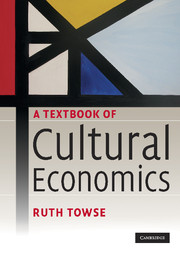Book contents
- Frontmatter
- Contents
- List of figures
- List of tables
- List of boxes
- List of abbreviations
- Preface
- Part I General issues in cultural economics
- Introduction
- 1 Introduction to cultural economics
- 2 Economic profile of the cultural sector
- 3 Markets for cultural goods and services
- 4 Economic organisation of the creative industries
- 5 Production, costs and supply of cultural goods
- 6 Consumption of cultural goods and services
- 7 Welfare economics and public finance
- Part II The ‘traditional’ economics of the arts and heritage
- Part III Artists' labour markets and copyright
- Part IV The creative industries
- Part V Conclusion and exercises and problems
- References
- Index
3 - Markets for cultural goods and services
- Frontmatter
- Contents
- List of figures
- List of tables
- List of boxes
- List of abbreviations
- Preface
- Part I General issues in cultural economics
- Introduction
- 1 Introduction to cultural economics
- 2 Economic profile of the cultural sector
- 3 Markets for cultural goods and services
- 4 Economic organisation of the creative industries
- 5 Production, costs and supply of cultural goods
- 6 Consumption of cultural goods and services
- 7 Welfare economics and public finance
- Part II The ‘traditional’ economics of the arts and heritage
- Part III Artists' labour markets and copyright
- Part IV The creative industries
- Part V Conclusion and exercises and problems
- References
- Index
Summary
In this chapter, we first define the operations of the market economy for cultural products – what economists mean by markets, how markets work in theory and the role of the price mechanism. Few markets in any sector of the economy work entirely without some form of regulation, however, and intervention in the market is widespread; this is especially true of the cultural sector, and it is another aspect of the mixed economy model mentioned in the previous chapter. The second part of the chapter goes on to consider the historical development of markets for various cultural products; this shows the emergence of the role of markets, some of which continue to function in much the same way today. Finally, the main features are outlined of the industries that make up the present-day cultural sector, which are analysed in detail in Part IV of the book. This chapter also paves the way for chapters 5 and 6, which go in depth into the theory of supply and demand in the context of the creative industries, and for chapters 7 and 10, in which intervention in the working of the market economy by government is discussed.
The market economy
Why look at markets for cultural products?
One of the chief topics in cultural economics is whether the market economy can meet the demands of society for cultural products. Should it fail to do so, the government may intervene to try to ensure that the aims of cultural policy are met.
- Type
- Chapter
- Information
- A Textbook of Cultural Economics , pp. 51 - 75Publisher: Cambridge University PressPrint publication year: 2010



